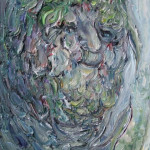As all the cultures of the nations of the world Lithuanian nation is rich by its mythology and has a model of world structure in the composition of which ancient Lithuanian mythology is. Here mythology means the description of the corner meanings of life of the world and man by images in which various animals, plants, things or phenomena express the profound layers of human existence. Nowadays as well in our consciousness the remains of the archetypal (mythological) models of world perception are hidden to which a spiritualized perception of the world phenomena surrounding man is typical. The central part in the life of ancient man was occupied by the conception of God. Besides the Head God various deities, goddesses, witches and other supernatural creatures which had their place and destination in the consciousness of ancient man and his everyday life were plentiful. In mythology cosmogonic myths are essential – as a means to return to eternity (painting “The Gates of the Earth”, “Cosmogonies 1, 2, 3, 4, 5”). In the oldest cosmogonic mythology the supernatural Ancestress –life-bearer (painting “Ancestress”) who was the Great Goddess mother which was considered to be the great goddess, life- bearer, guardian of fertility and was identified with the Earth and often it is called Earth – the Mother appeared.
One of the oldest spheres of totem religion are the cults of trees, plants. Trees are totems, trees are the abodes of the ancestor souls (lime-tree, birch, fir-tree, pear-tree, apple-tree). At present as well often in the place of the man’s death and place of the grave totem trees are planted. Totem birds are the cuckoo, owl, nightingale in which as it is believed the souls of the ancestors used to incarnate. On the top of full of birds pear-tree painted in the painting “Chorus of the Birds” a cuckoo is perched, a soul has also incarnated in the bird in the painting “The Beautiful Bird”.
The cult of grass-snake totem (painting “Grass-snake”) remained including the time when the cult of ancestors strengthened. Certain earth (as underground creatures) were attributed to the grass-snakes, painting “The Grass-snake”, “The Gate of the Earth”.
The cult of fire took an important place in the Lithuanian mythology. Fire as the intermediary of the worlds functions nowadays in the consciousness of a Lithuanian as well in the necrocult tradition. The cult of fire can be divided into several parts.
Ancient:
- Keeping on and worshipping eternal fire on the sacrifice hills and by the holy trees – oaks.
- Worshipping of home hearth fire.
Present:
- Fire as the intermediary of the worlds functions nowadays in the consciousness of a Lithuanian in the necrocult tradition.
- Burning of fire during various festivities.
In Samogitia one of the paganism and mythic world places was Satrija sacrifice hill (painting “Satrija”) on which the idols of the old religion used to stand (painting “Samogitian Idol”) and eternal fire was kept on (paintings “Fire”, “Flame”). The representatives of prophet estate – senior priests and priestesses looked after the fire (paintings “Fire”, “Priestess”, “Offering”).
The great Equinox festival (St. John’s Day) till present are celebrated on Rambynas hill. Rasa festival is related with the cult of worshipping of sun and water and coincides with the period of the longest day June 24 – 29 (painting “St.John’s Day Ferns”, “Sun of Midday”).
The cult of heavenly bodies was typical of Lithuanian mythology as well. Some of the principal worshipped objects were the Sun and the Moon.
In Lithuania stone totems were common as well. Stabakulis are stone posts it was believed that in them the souls of the dead persons incarnate, Lithuanians used to erect them on the graves of the dead. Nowadays stones are respected as well, they are erected in the grave-yards, on the crossroads, at the entrance to the farmstead and so on.
Stones of bowl form were like altars on which the offering was placed, these stones have the images and symbols of sun, moon, stars on them, they certify about the cult of heavenly bodies, on them offering was placed (Painting “Offering” has been painted according to the stone of bowl form which is located by Minija river, not far from Klaipeda).
Virginijus Kašinskas.









